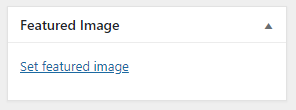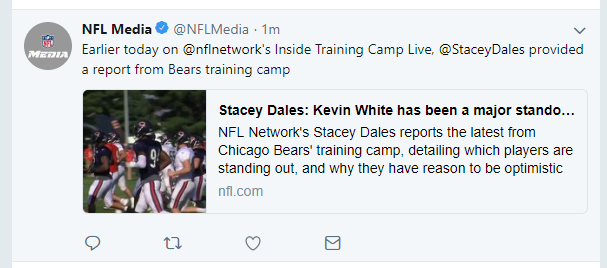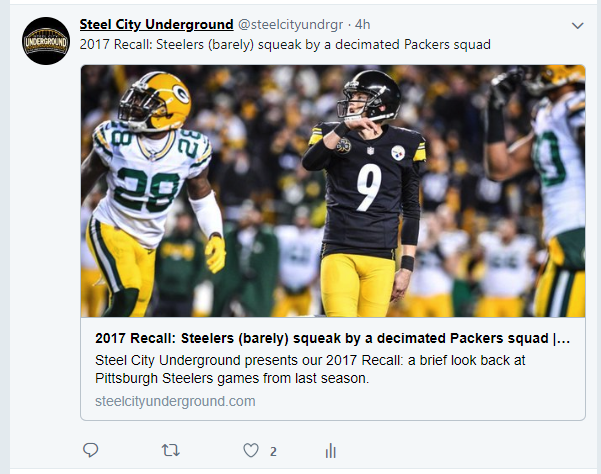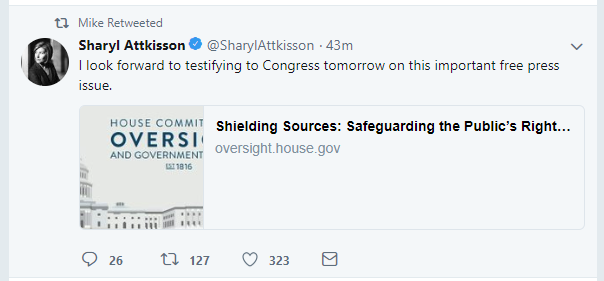
Facebook isn’t the only social media platform you should be on
Believe it or not, I get asked to “post this on Facebook” more often than you’d think.
I’m not sure if the word “Facebook” has become synonymous with social media in that way that we now “Google” things or when we used to “Xerox” copies, but that question sometimes makes me wonder if people realize there’s an entire world of options out there besides the giant that is Facebook?
Let me backtrack before I get into those options: you absolutely should be on Facebook. No if’s, and’s or but’s about it! Facebook is the king of the proverbial social media jungle. It has the most users and may get you your biggest bang for your advertising buck. It’s not often I come across someone who doesn’t want to be on Facebook, but I meet resistance (or even blank stares) when mentioning the benefits of other platforms.
I strongly believe you don’t need to be on every social media platform. I previously talked about the positives and negatives of several social media networks, but need to go into detail about the pitfalls of only being visible on a single platform.
Competition
Facebook is the biggest of them all, but that also means you may have more competition. If you’re not a niche brand or product, you could easily get swept under the rug. Therefore, if Facebook is your only means of advertising, that isn’t good.
I always advocate leveraging social media to bring that potential audience back to your website. However, if you’re only broadcasting to a single pool of people, that also isn’t any good.
Audience
Oftentimes your Facebook page is going to begin with immediate friends and family who you invite to like your page. You have to cast your net a bit wider to find strangers. The best way to do that is jumping into services that cater to the general public.
Twitter is by and large the biggest platform to do so. While Instagram is growing, you cannot link back to your site within individual posts there (which also have to be anchored by posting a photo). On Twitter you can easily send out short, quick messages. As with any service there’s a caveat: tweets are limited to roughly 280 characters (pending photo attachments and links) plus Twitter is like a newswire in that the information is consumed as fast as it vanishes. (Almost instantly.)
While I made that comment about Instagram, the service links up nicely with Facebook (their owner) and can help you cross-promote to both your business page audiences.
Search
Facebook and Twitter posts rank high when using Google. There’s a strong possibility that your posts there on a particular topic will rank higher than your own website. (Note: that’s typical and nothing to be discouraged about.)
YouTube videos will always rank higher on Google than regular text posts. Since video is a hot medium and Google owns YouTube, it would behoove you to create a channel and post clips, if you have them. (As always, make sure you have links in your description!)
Pinterest and Google Plus can regularly show up high in web searches as well. While they may not have the same market penetration as the bigger sites, image searches routinely find pinned items on Pinterest boards or pull from a story posted to Google Plus. With Google’s 90% or more market share of web search, even a “ghost town” such as Google Plus (which has some dedicated users who refuse to use Facebook, etc.) has a positive benefit to sharing there.
Business-To-Business
Business professionals should be on LinkedIn, but should also be aware that some of the platform’s features are paid-only. The best way to leverage LinkedIn’s benefits is to keep your personal resume up-to-date. Business pages don’t get a lot of play in the general day-to-day use of LinkedIn, nor will you have much success cold-contacting individuals with sales pitches. (LinkedIn has been anti-spam for a while now.)
If you can dedicate the time, simply sharing your content to your personal profile or in community groups where it’s acceptable is the best avenue to using this service.
Conclusion
Finding what social media platforms work best for your social media marketing campaign can be a trial and error process. If you find that you’re not gaining traction on one service, give it some time and then try another.
The focus of this article was to get you thinking about more than Facebook. With Facebook’s fight against “fake news” and a recent privacy scare, they’re becoming a more difficult platform for businesses to effectively use without paying for the privilege.
Also, if you haven’t broken out beyond a “friends and family” audience, it’s time to start finding outsiders by using other services as part of your overall strategy. However, SEO benefits are the main reason you want to amplify your message to as many services you can comfortably, and consistently, keep updated.
Some of those circles may overlap, but in the end, you want to have your entire net cast as wide as possible: you never know when one of those paths will lead someone back to your business.
Why rushing to publish content isn’t advisable
In my line of work, I often see some dubious requests. Among those are to publish a blog post ASAP or worse yet, post several articles within a single day.
That wouldn’t be such a bad strategy for someone consistently producing content (think: newspaper). However, most of the clients I work with struggle to produce content even on a weekly or bi-weekly basis. Often, they’ll have a productive day where they write a new article full of advice or several similar smaller posts.
The reaction is almost always the same:
Publish these ASAP!
I usually question the motive. Sometimes you may be in a line of work where deadlines necessitate such a move. The piece in question should be brought out into the public eye as soon as possible.
Most of the time that’s not the case. Rushing to publish something at 5 pm, when everyone is leaving work, isn’t going to get it in front of more eyeballs than if you wait until the morning. In fact, if this is shared on social media (especially if you have automation tools which post it to Facebook or Twitter as soon as its published) you’re more than likely doing yourself a disservice based on the volatility of social media. Tweets disappear almost instantly. Facebook posts scatter around the ether.
The advantage of posting now soon become a disadvantage.
The same can be said for the day of the week you post on. You need to know your audience. For example, business blogs should focus on publishing between Monday and Friday. However, posting Friday afternoon probably isn’t advisable either, as most businesspeople are wrapping up their week. Monday mornings could also have the same disadvantage though, depending on the medium you are broadcasting your new article, it may get more play through that afternoon and into the coming days of the week.
I also have to hold back some overzealous types from wanting to publish and/or post four blogs in a single day. There is no advantage to that and it could be even worse than an ill-advised sports article posting while that team’s fans are watching them play a game! (Okay, that might be the worst scenario, but bear with me.) Should you make multiple posts in a single day, you’re making those individual articles compete for attention with one another. Worse, if your homepage and/or blog only show the last X number of posts, where X is 2 and you post 3 new articles, that means the third blog won’t be visible on those pages.
Even your most hardcore readers may not see that additional post.
Ditto for social media. On a medium where you’re already competing for eyeballs with other people or businesses posting information, there’s a negative benefit to blowing through all of your content at once.
The final and the most obvious problem with rushing to publish content is making errors. A small typo may not be the end of the world, but factual information such as math, dates, times, etc. could make all of the difference between positioning yourself as an expert and looking like you don’t know your subject matter.
Therefore, the optimal strategy with producing any content is to be consistent. It’s one of my mantras, but it holds true. It’s better to have a small stack of ready-to-go content that you can publish as a steady stream to your audience than burn through all of it in one fell swoop. Organizing your efforts and spreading them out over time will reap greater rewards than a “now” mentality.
I have several tools which I like to use to plan out when my content is published. You can find this on my resources page. In addition, you’ll also find tools to help you post to social media more efficiently. You can always re-post to social media in the future. As long as you’re not spamming your audience they may even revisit your blog post or podcast which they started but didn’t finish, or they may refer it to a friend.
In that way, you can put your eggs in different baskets, save yourself some time and stress, and set forth on a successful content marketing campaign.
Why one of my favorite mottos is “Why not?”
I believe that one of my biggest obstacles, even including what I publish on this website or via the DisContent podcast, is overthinking things. Far too often we can outsmart ourselves; that’s never for the better.
There was a time where I thought “Who would read that?” or “Who would listen to this?” Those types of thoughts are self-defeating. You don’t even attempt to run in the race, so to speak, because you don’t even line up at the start.
Somehow, I got over that hurdle. It may have been a nudge or a small push by a friend or a family member, or just having something get under my skin enough to say “alright, I’ll try this.” Once I made that leap and consistently made an effort to write blog posts or record podcasts, I realized that if you have something worth saying, then yes, people will read or listen.
Furthermore, that audience is more than I ever could’ve imagined. When I look back on my hesitation, I often wonder what may have happened if I had jumped at the opportunity presented to me sooner.
That’s where one of my go-to sayings originated. Working within groups or teams in a leadership capacity, I was often pitched ideas. I didn’t want to shut down any ideas right away, no matter how bad it may have appeared on the onset. Doing so will shut down the group and risk never getting any new ideas.
Somewhere out of those brainstorming sessions, a motto was born out of necessity: “Why not?” We would receive a proposal and approach it in a new way. This is opposed to when I found myself shutting down ideas before giving them any real thought.
“That won’t work.”
That’s how I used to think. When those words came out of my mouth they did so for no good reason. Replacing them with “Why not?” forced me to find reasons to not do something. This is all within good reason, of course. Expensive ideas when working within the confines of a budget may never work. However, when the only expense is your time or energy, it becomes harder to come up with excuses.
In fact, excuses expose themselves as excuses.
With no excuses in the way, “why not” has led me to do things I never imagined possible. I’ve met extraordinary people and have made business deals which otherwise would’ve never materialized. If I wouldn’t have had that mentality, I would have immediately slam shut a door in which an opportunity may have opened.
That’s how the “why not” principle has been applied to my content marketing strategy. If you’re thinking a blog, podcast, or social media campaign won’t pay dividends, I beg you to ask yourself the same question:
Why not?
If you can’t come up with good reasons then it’s time to take the dive. (And by good reasons, I don’t mean not having the technology or the know-how: those things are readily available and sometimes at no cost by marketing consultants such as myself.)
Sometimes I come off sounding like a cheerleader when it comes to encouraging people to get into content marketing: I promise you, you’ll feel more like your own cheerleader when your efforts pay off.
I know I sure do.
Nowadays when I’m approached with an idea I find myself asking the same question. I have to force myself to come up with a compelling reason as to “Why not?” before closing those doors of potential opportunity.
However, keep in mind that asking this simple two-word question doesn’t mean you say “yes” to every proposal which comes your way either. While it’s difficult to say no in some situations, especially if you’re starting out, the two-letter word “N-O” must also be a part of your vocabulary. Otherwise, you find yourself with no filter and in the center of a bunch of potentially poor business decisions.
Simply put, “why not” is a way to add a filter before automatically entering the rejection phase. Making it a motto forces you to think things over and proceed with caution. Once you have a knack for what works and what doesn’t, the “Why not?” mentality will become easier to implement.
And when it does, you will reap the rewards of breaking barriers by not setting artificial limits on your marketing efforts.
“Picture perfect” images and graphics on Social Media
If you’ve ever heard the idiom “A picture is worth a thousand words” there is no truer sense of the word when associated with content marketing. The last thing you want is an image that doesn’t properly fit on your blog or looks out of place on social media.
There’s no doubt about it: photos and images help your content marketing efforts get attention. Much more attention!
That’s why it’s important to make sure you not only have photos on your blog posts, but that they are properly formatted to avoid some of the problems commonly seen when you share your links on social media. I’ll give some examples of those issues below and how you can avoid them.

The right image
Almost always, I try to avoid using any graphics with text on them. One of the chief reasons is that Facebook will charge you more when boosting your post… or worse, they will not allow you to use it as part of an advertising campaign.
Don’t ask me why, but that’s their rules. We have to play by them.
The other reason is to avoid having text “chopped off” when your link is shared. Therefore, you’ll notice that I refer to “photos” below, but this pertains to any graphic image. Less text is better: no text is best. Leave the typing to what you write in your blog or the description within your post.

It all starts with your blog
If your image isn’t properly formatted on your blog, then it won’t be properly formatted on the various social media networks you may share it on.
For those of you using WordPress, Facebook will traditionally look for the first image in your blog posts and associate it when sharing. Ditto for other platforms such as Twitter and Google Plus.
Therefore, it’s imperative that image is formatted correctly. I’ve found that a landscape-oriented image with a size of 1024px by 512px is the optimal size when sharing your posts across platforms. Facebook can handle any square image so long as it’s at least 600px wide on one side, however, Twitter will crop square images, particularly on their mobile applications.
There are many imaging programs which will allow you to crop your photos to this specific size. One popular option is Adobe Photoshop, which is a commercial application. For those on a budget, you can try open source or free programs such as GIMP, XnView or Microsoft Paint (or its newest incarnation, Paint 3D).
There is also a plethora of smartphone apps which can do the same: a simple search should be able to show you which ones are available. From there, it’s just a matter of personal preference as to which one is more user friendly and fits your needs.
Once you have a 1024×512 image, its time to place the photo in your blog. For the 70% or more of you out there, chances are you’re using WordPress. That means you will have a featured image box from which to set the main graphic associated with your post.
That box is usually part of the sidebar and looks like this:

To help Facebook and Twitter know your featured image is the “main photo” to accompany your blog post, you can also install the Yoast SEO Plugin. Once activated simply double-check that Facebook Open Graph meta data and Twitter card meta data are both enabled under Yoast’s social settings section.
This is a one-time setting, so once you save the changes, all of your blog posts (past, present or future) will have those social meta tags included.
That’s it! Now you’re set to share your post. However, let’s look at what some of the downfalls of not using properly formatted images might look like.
Using small images
I probably see this more often than I should. With the advent of high definition computer and smartphone screens its as important as ever to not use tiny “postage stamp” sized images on your blog.
Or else, this is what will happen:

You will need images that have a good resolution but are not too big either. As you can see, this is far less eye-catching as when a properly formatted image is used:

(Note: while these examples are from Twitter this will appear similarly on Facebook too.)
Also keep in mind: bigger doesn’t always mean better.
The reason I recommend images sized 1024px in width is that embedding large images on your website will slow it down. When your page load speed decreases, your SEO will be penalized. It’s a careful balance as you want to be found by Google and look good on social media.
WordPress can only handle certain sized images internally too. If you upload an image that’s too big, it may get rejected or worse, crash your website. So be careful in making sure you format your images before uploading them to your blog.
Avoid Text
This post not only ignores the size of the image but also fails to consider text being cropped:

There’s no benefit to adding wording to your images if they are featured images for your blog. A post or banner added to a social media post promoting an event without a link, of course, is acceptable. It may still be governed by the same rules as sharing links, but in many cases an event flyer or poster is a necessary evil to share. (Just be aware of how cropped images could make your presence look less than professional.)
In any other situation you should attempt to put necessary text within the description of the social media post followed by the shared URL. In this way, your message won’t get truncated.
The Wrong Format
Nothing could be more embarrassing than having someone’s head chopped off in a photo:

While this may still happen on some devices even with the recommended 1024×512 image size, your chances are greater that it will not.
Therefore, heed my advice throughout this article in optimizing your images before putting them on your blog or sharing them on social media.
Don’t be on social media for the sake of being on social media
This may seem like an odd title for an article when one of my main pillars of content marketing is social media. However, in the tradition of one of my go-to mottos, “Don’t worry about being great; just be good”, getting your name on every social media platform could end up having a negative impact in many ways.
For example, say you start a Pinterest page for your business but never update it: an abandoned or dormant social media page could make your business look “out of business”. Depending on your industry, that could be a really bad thing. In the case of what I do for a living, working as a social media manager, not keeping my own pages up-to-date would make me look incompetent at doing my own job!
Just think: if this guy can’t keep his own sites up-to-date what is he going to do with mine?
The same could be said for a restaurant that hasn’t posted since 2015: are they still open? Or even your general services, such as landscaping: can I contact this person through Facebook? Will they answer?
Oftentimes your social media pages may show up higher than your own website in search rankings. That means a potential customer or client could land on your Facebook or Twitter profile instead of your website: if that were to happen, what kind of first impression would you like to make on them?
By all means, this doesn’t mean that you have to post daily. I’m a firm believer of being consistent, but even an update once or twice a week, something that will only set you back a few minutes each day, is more than sufficient. There are also tools to make sure you can save time by not having to log in to each social media network individually. You don’t need to overextend yourself in that regard.
Another thing to consider is what networks you have a profile on. I’ll give some ideas on which are the most, and least, beneficial to your brand below.
I can’t give you a reason to not be on the world’s largest platform. I understand that some people don’t want to be personally involved with Facebook for one reason or another, however, in terms of leveraging the reach of your business, Facebook offers the most bang for your buck.
It’s also a platform where it can be difficult to be seen. Initially, you are going to build your Facebook friend from your personal network, which often consists of family and friends. Cracking the nut outside of that circle could prove difficult, especially with recent changes to the platform. In all likelihood, you will need to spend money on ads but don’t worry: it’s nowhere near the cost of placing an ad in traditional media such as TV, radio, or newspapers, nor is it as competitive or costly as Google AdWords.
In fact, as a business, you will have to spend money on advertising to be seen on Facebook, but at least you will by doing so. Other platforms have tried but are not as successful at getting your name out there as Facebook is.
Facebook also has its own internal search engine which can help you get noticed just as well or better than searching for your brand on Google. Therefore, everyone should be on this network and utilize it as best as possible.
Twitter is also becoming another tough cookie to crumble but remains one of the larger networks to reach “strangers”: that is, people outside of your friends and family.
Since many tools allow you to post simultaneously to Facebook and Twitter, I don’t see any reason you shouldn’t be on both. Just don’t sweat having a lot of followers: that comes in due time if you have an incentive to pay attention to what you tweet.
This may come as a surprise, but I don’t find incredible value in Instagram unless you have a brand that people get excited about. Think of a popular local event like a festival or a restaurant that has brand loyalty. Since Instagram is based on posting photos, those types of businesses tend to have photography which will get people excited to pay attention to you. The pictures sell themselves.
However, some companies would be better off focusing their content marketing efforts elsewhere. If you have to produce graphics to publish on Instagram (which has no dedicated web platform and requires the use of a smartphone) it can become a time sink. Remodeling companies with before and after photos will benefit far greater from an Instagram presence than a book author might, as authors are selling words and often don’t have photographs (other than a book cover) that would necessitate using this platform.
Instagram doesn’t hyperlink any URLs you place within your posts, also negating the true SEO value of social media. Keep this in mind as you decide what platforms you should be on and how much time to dedicate to updating each.
The Best of the Rest
Google Plus may look like a ghost town for social media purposes but posting there will still net you positive results when someone searches for you on Google. (Play in their sandbox!)
Ditto if you have videos posted to YouTube. Video will actually get better search results, so YouTube could end up being your best bet above all the services mentioned.
Pinterest suffers from some of the same issues I’ve discussed about Instagram. However, Pinterest has links back to your site/content. The main problem is that anytime you see something on Pinterest, it’s the photo (and not necessarily your business name or link) which is the main focus of what’s being shared and where. Pinterest might work best for those in an arts and crafts industry, selling goods on sites such as Etsy.
Snapchat is so far out there it surprises me businesses are on it at all. It’s a play for younger eyeballs on your materials, but oftentimes making an effort toward a very specific demo is negatively impacting your efforts by only focusing on a small percentage of potential customers. There’s nothing wrong with being on this service but beware of the short lifespan nature of its disappearing content. (Which is also a concern with Instagram and Facebook stories.)
LinkedIn is a no-brainer to network with professionals, but business pages often go ignored here. You’ll likely have to reshare content using your personal account for it to gain any traction there.
Conclusion
Get on the services you feel you will be able to keep up with best. Facebook and Twitter can be posted to at the same time. Google Plus can also be added to that list, and oftentimes LinkedIn as well. Instagram, Pinterest, YouTube, and Snapchat all have their own APIs which usually aren’t tied into social media management platforms.
That could cost you more time and effort, so be sure to weigh the benefit of having to regularly update each of these accounts, sometimes individually, before taking the dive “just to be on them for the sake of being on them”.
5 tools that will help you save time posting to social media
I’m often asked which programs help me most efficiently and effectively run my social media campaigns.
To be honest, quite a few of these programs aren’t specific to social media, but they are incredibly helpful in my daily workflow. Let’s take a look at five of my favorite apps and how they could help your content marketing efforts.
Dropbox
If I could only have one app, Dropbox is it!
If you’re not familiar with Dropbox, it’s a cloud storage application which works on a variety of platforms. The genius of using it for social media is when you must take files on the go. It’s one of the primary ways I get photos and custom graphics onto Instagram, by creating those images on a computer first, saving them to my Dropbox, and then accessing them later via a smartphone or tablet.
You can try Dropbox for free with limited storage and features. This free tier may be more than enough for your needs too, but there are also paid upgrades which can increase your storage space exponentially and also act as a backup for your important files.
Hootsuite
Labeled as a “social media dashboard” the main reason you may want to use Hootsuite is for posting to multiple social media networks all at once. It also acts as a powerful scheduling platform and can assist you in monitoring all of your networks from one area.
Hootsuite’s free plan will allow you to add up to three networks: Facebook, Twitter, Google Plus and LinkedIn are among those you can post to at no charge, with up to 30 total posts per day. (Other platforms, such as Instagram, are available with paid plans: honestly, it’s not worth it, as it doesn’t operate in the same manner.)
They also offer a more limited mobile app that will allow you to do much of the same from a smartphone but be aware that the more powerful (and far more complicated interface) lies in using a traditional web browser via a PC or MAC.
Trello
Okay, I lied: if I could have only one app, Trello might do it for me.
A highly customizable project management tool, Trello can be manipulated to run everything from your blog post editorial calendar to a grocery list. It’s one of the coolest applications I’ve found in recent years and I nearly use it for everything.
Trello begins with a “board” but then filters into individual “lists” and “cards”. The magic of these cards is that you can set due dates, leave comments, add checklists, attach files and more.
If you want to be consistent in your marketing efforts, I highly suggest checking Trello out.
Pushbullet
Have you ever felt the need to copy something to your phone from your computer? Or send a link, text, or a photo from your phone to another device?
Look no further than Pushbullet, an application which works like a universal clipboard.
Now you can safely type your social media posts from a computer, paste it into Pushbullet, and then copy/paste it on your phone to wherever you need. You can also quickly retrieve photos from your phone’s camera and “push” them to a computer for editing.
The interface is a bit too simple, however, which is why I also recommend…
Evernote
The king of notetaking apps limited their free plans a little over a year ago but is still a go-to program of mine.
Literally available anywhere, Evernote has dedicated phone and tablet apps, as well as software for PC and MAC computers. However, any web browser in the world will give you access to taking notes and more.
While this program also offers many features of those above, such as checklists or embedding photos and files, the company has a limit on the amount of storage space you can use, plus it can be a bit more daunting to organize these extras in the same way as Trello or Dropbox can.
The true genius of Evernote is sticking to text: as you’re aware, spellcheck can be a bummer on a small screens (especially if you have fat thumbs) but Evernote will allow you to use some voice dictation software, like Siri or Alexa, to potentially save you time and help you take a virtual notepad with you anywhere for when inspiration strikes.
Don’t obsess over making mistakes
One mantra you may hear me repeat a lot through my written and audio formats I produce content on is “be good, not great”.
I’d like to better explain the philosophy behind that statement. I want everyone to be great, but in most cases, content marketing and platform building are secondary to your main business. If you make pizzas or build cabinets for a living, be great at doing those.
Be good at doing this.
It’s lowering the bar, but with good reason. As you write a blog, record a podcast, or post to social media, you don’t want added stress. I know all too well what it’s like to be a perfectionist and stressing over every little detail in this overwhelming publishing world that is content marketing could become cumbersome.
Now, being “good” doesn’t give you a pass to put out lousy information or blatantly skip over proofreading your material either! By all means, take some shortcuts to not only save yourself time but relieve yourself of any added pressure these additional marketing tasks may bring along with them.
Spellcheck is your friend, but we can all miss a word here or there, but unless you’re an author, readers will understand you’re an expert in your field, not at being a wordsmith.
If you record a podcast, an errant sound at times (like air conditioning kicking on or a pet making racket) may seem like the end of the world: but it’s not. Your audience may notice but will quickly forget.
However, don’t make a habit out of having bad habits. You don’t want to be poor, you want to be at least good. If you can achieve greatness, that’s even better. In the end, the goal isn’t to be a perfectionist at writing or recording: it’s to further spread the word about your brand.
Small mistakes won’t derail your efforts but constant errors or a deluge of poor content can turn off even the most avid of your advocates.
So, focus on being good. Use a word processing program to type up your blog or social media posts and re-read them at least once to hone in on any potential errors before letting them into the wild.
If you’re recording audio or video, don’t sweat small details, but make a concerted effort to remove certain unnecessary words or long pauses from those recordings, or if possible, edit them out. (Editing takes more time, obviously, so try to make a habit of not doing that to save you some precious moments!)
And last but not least, you will learn by making mistakes. That’s the main reason you shouldn’t obsess over them. As you continue to consistently publish new content you will refine your process and eventually become a pro.
You’ll be great, not good. But to coin a baseball reference, don’t swing for the fences first. You have to settle for some base hits before you can go all the way to Homeplate!
Why every website on Earth needs a blog
This may sound like a bold claim, but I’m of the firm belief that every website must have a blog.
Blogs may not always have positive idea behind them, but you’d be hard-pressed to find anyone online that doesn’t believe they have merit. With a blog, you can express your opinions, promote products or services, position yourself as an expert, establish yourself as an expert or connect with others like you.
It can literally be a kitchen sink for updates too. If you have a press release, new news, an upcoming event, answer a question or simply want to get something off your chest, a blog can house all of these types of articles and then some.
Blog can also be a way to have fun, stay updated within a certain field (by doing research as part of your writing) or best of all, a blog could end up making you money.
The last part is important, but not to be taken for granted. Soliciting enough clicks to visit your website may be too big of a battle to quit your day job, but you can never say never. Internet personality Gary Vaynerchuk started as a wine critic before ascending to viral fame. But even if that type of celebrity isn’t in the cards for you, at the very least you may increase your footprint to make people aware of yourself, you brand and/or your products and services.
That alone may lead to more leads, and sales, than you would’ve had without a blog.
Which leads me (pun intended) to the biggest benefit I feel anyone can gain from blogging: leading people back to your website.
Hopefully you have a well-built website which puts calls to action and sales pitches front-and-center. Visitors to your site may feel compelled to look around and see what you have, all because a well-crafted blog post brought them there.
In closing, don’t discount the benefits of having a blog. Oftentimes, the ability to start a blog (if you don’t already have one) is only a few clicks away. Coming up with topics may not be difficult and in the end, you can begin generating a buzz about yourself by simply typing away as you would on Facebook or a text message.
A few minutes of blogging a week can lead to great results down the road.
So why do you need a blog? Maybe the better question is why would someone not need one?!
Being “good” and not “great” will save you from “content stress”
If you’ve listened to the last few episodes of the DisContent Podcast, you may have heard me use the phrase “you only have to be good, not great”.
That statement doesn’t refer to your actual expertise, rather, is a statement I make to help downplay the stress which can occur from overwhelming yourself with the pressures of content marketing.
Some of those pressures can include being a perfectionist. While having proper grammar in a blog post or making sure a dog isn’t barking in the background while recording a podcast can take you from looking like an amateur to a professional, those steps are far more important than concerning yourself with speaking for exactly twenty minutes or imposing a 1,000-word quota for your articles.
Be “good” and the “great” will come. Focus on those things you are best at and let the content come naturally. Adding negative influencers, such as stressing over strict deadlines and content guidelines will only hinder your best efforts.
It can also make even the most persistent people quite overnight.
That’s why you can make your own rules. The only one I feel people should implement 100% of the way when undertaking a new blog, podcast, or social media campaign, is to stay consistent. You make the schedule, but at the same time, stick to it.
Another big part of consistency is practicing what you preach. Obviously, if you’re not a writer or editor (like myself) you can get away with a spelling error here or there. Stick to what can be forgiven.
However, if you provide a service and post a photo on Instagram that goes against your best practices, you’re only doing yourself a disservice.
Therefore, when you begin (or continue) with your content marketing efforts, make sure you stay firm to appear professional, but don’t sweat the small details. No one needs to spend hours on a script to read during a podcast. If a blog entry is only 400 words, don’t force more just for the sake of stuffing words into it.
Sometimes the simple path is the best one. In this case, don’t overextend yourself by raising expectations. In due time you will create an audience who will encourage and help you achieve greatness.
And all it took to get there was doing good stuff!
There are no “secrets” to content marketing
Far too often I speak with people who are too concerned with finding that “missing piece of the puzzle” when it comes to content marketing. Everyone is trying to sell them the latest widget that will make them the best and stand out more than the competitor. They also promise shortcuts which makes things easier.
The truth to the matter is, there are no secrets to doing this line of work. In fact, content marketing is what you make of it.
That is, the time and effort involved to stand out. Now, that doesn’t mean there are more efficient or easier ways to do what you’re already doing. (Or get you to do it more efficiently or easier, if you’re not doing anything right now!)
But first things first: like anything else you may be involved in, you’re only going to receive what you put in. “Sweat equity” is a tried and true component of content marketing. How often you post to your Facebook page or reply to tweets will dictate engagement, and amplification, more than anything else you can do.
If someone sends you a message: respond.
If someone comments, click that like/favorite button or if you feel compelled, reply!
It’s easy and only takes a few moments of your time each day. Maybe even every other day, depending on what field you’re working in. That may seem daunting, but it doesn’t have to be.
Another thing you don’t have to be is a slave to content.
I see far too many eyes glaze over at the thought of becoming a part-time publishing house in addition to their existing duties within their job description. They overthink, are then overwhelmed and end up quitting before they ever begin.
That’s why I mean it when I say: content marketing doesn’t have to be a scary word.
This is your blog. Your podcast. Your social media page.
Yes, I’m operating an entire platform that tells you how to do this stuff, but you still play by your rules. While it’s still important to make a schedule and adhere to it, you are the one who decides when you do that work.
So, the only “secret” that may not be public knowledge when it comes to social media, blogs, or podcasts is “consistency”. The only way to gain the loyalty of your followers is to be consistent. Don’t insult their loyalty by
Those loyal followers you gain trust consistency. And that’s really the only “secret” to content marketing: be consistent. If you do updates weekly, do them weekly. If it’s every Monday, do that. Regardless, do what works for you, in this moment and on your terms.
And if you happen to have a lapse, where for some reason you can’t make that blog post or publish a Facebook update, don’t sweat it. We all get caught up. Your followers are following, but they too have a schedule to stick to. One miss here or there isn’t the end of the world and would likely be missed on holidays were a flood of happenings are stealing your audience’s attention.
In other words, they might miss your latest and greatest article or episode. But they’ll be back… as long as you aren’t inconsistent and can’t be followed. So, don’t miss too much and don’t abandon your blog or your Pinterest page. There’s nothing worse than someone wondering if you’re still in existence because your last post was November 2016.
Worse yet, how can you ask for followers when you’re too hard to follow?